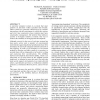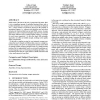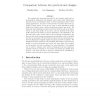35 search results - page 4 / 7 » Achieving Cost-Effective Software Reliability Through Self-H... |
ICFEM
1997
Springer
13 years 11 months ago
1997
Springer
A real-time computer system is a system that must perform its functions within specified time bounds. These systems are generally characterized by complex interactions with the en...
WOSP
1998
ACM
13 years 12 months ago
1998
ACM
Increasingly, new applications are being built by composing existing software components rather than by coding a system from scratch. Using this approach, applications can be buil...
CODES
2009
IEEE
14 years 2 months ago
2009
IEEE
Time redundancy (rollback-recovery) and hardware redundancy are commonly used in real-time systems to achieve fault tolerance. From an energy consumption point of view, time redun...
WWW
2006
ACM
14 years 8 months ago
2006
ACM
While much of the data on the web is unstructured in nature, there is also a significant amount of embedded structured data, such as product information on e-commerce sites or sto...
ESORICS
2004
Springer
14 years 1 months ago
2004
Springer
We evaluate the anonymity provided by two popular email mix implementations, Mixmaster and Reliable, and compare their effectiveness through the use of simulations which model th...



